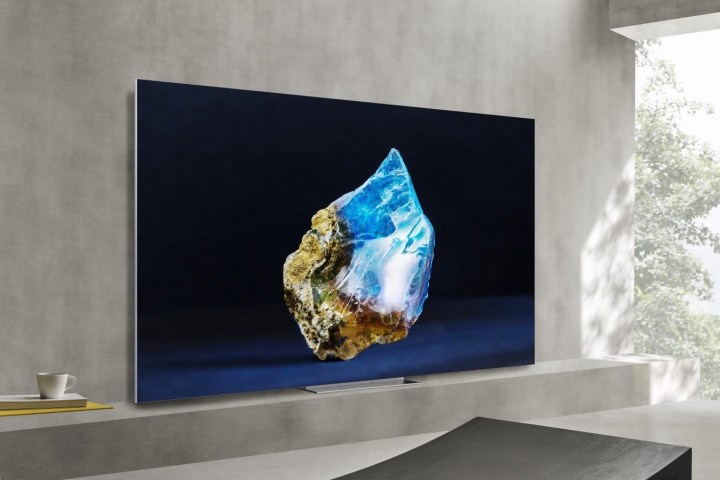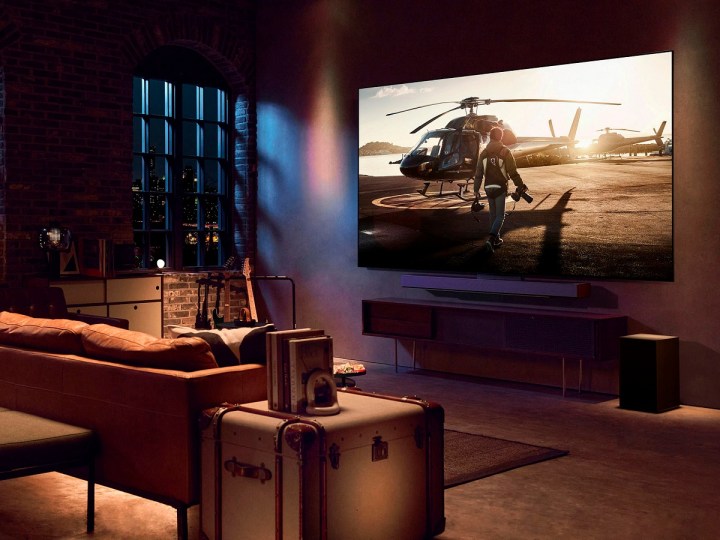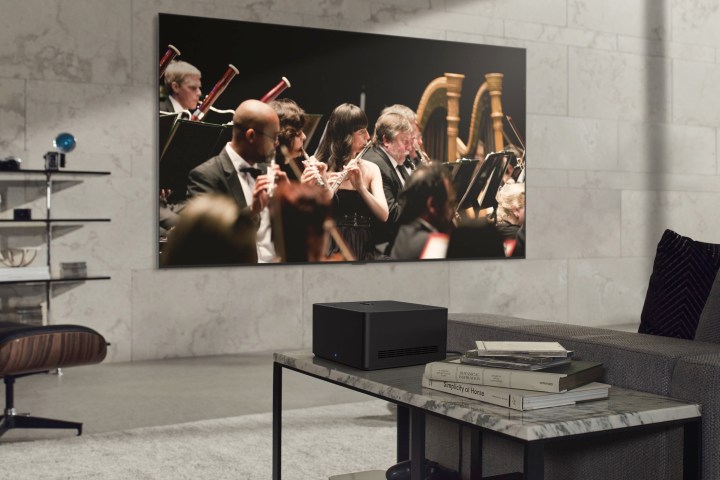If you’re shopping for a new TV, you’ve probably stumbled upon products that use OLED, LED, QLED, and even QD-OLED to describe their display. The world of electronics moves fast, and while the world was once in the throes of debating plasma vs. LCD, the game has now shifted to focus on an assortment of LED-based designs.
Trying to wrap your head around all the jargon can be challenging, especially since many of the terms look and sound nearly identical. Toss in quality disparities between brands and price tags that run from a few hundred bucks to well over $2,000, and it’s easy to get overwhelmed when looking for TVs.
Need some help on your search? Here’s everything you need to know about OLED and LED, including what the acronyms stand for, which is better, and other formats like QD-OLED and QLED.
If you’re in the market for a new TV, we’ve also rounded up the best 4K TV deals and the best OLED TV sales available.
What does LED mean?

Non-OLED TVs are made of two main parts: an LCD panel and a backlight. The LCD panel contains the pixels, the little colored dots that make up a TV’s image. On their own, pixels cannot be seen; they require a backlight. When light from the backlight shines through an LCD pixel, you can see its color.
The “LED” in LED TV simply refers to how the backlight is made. In the past, a thicker and less efficient technology called CCFL (cold-cathode fluorescent light) was used. But these days, virtually every flat-screen TV (sans OLED) uses LEDs as its source of backlighting. Thus, when you see the term “LED TV,” it simply refers to an LED-backlit LCD TV.
That said, not all LED TVs are created equal. There can be differences in the number and quality of the LEDs used, which leads to differences in things like brightness and black levels. For instance, you’ve probably heard of QLED TVs. This is a type of LED TV that uses quantum dots to achieve better brightness and color. We’ll discuss QLED more below, but here’s a great overview of the differences between QLED and OLED TVs.
What does OLED mean?

As mentioned, the “OLED” in OLED TV stands for “organic light-emitting diode.” OLEDs have the unusual property of being able to produce both light and color from a single diode when they’re fed electricity. Because of this, OLED TVs don’t need a separate backlight. Each pixel you see is a self-contained source of color and light.
Some of the inherent benefits of OLED screens are that they can be extremely thin and flexible. But the biggest benefit when we compare them to LED TVs is that each individual pixel receives its own luminance and power (as opposed to LED TVs, which have persistent pixels that require an external source of light to see). When it’s on, you can see it. When it’s off, it emits no light at all — it’s completely black. We’ll discuss how this affects black levels in a moment.
Currently, LG Display, famed for top-line LG OLEDs like the G3 Series, is the only manufacturer of OLED panels for TVs. And thanks to partnerships between LG Display and brands like Samsung and Sony, you’ll be able to buy Samsung and Sony OLEDs, such as the Samsung S95C and Sony A95L. While these models still use picture-processing tools developed by each respective company, the OLED panels are from LG Display.
Is QLED the same as OLED?

While those pesky acronyms may sound similar, an OLED TV is not the same as a QLED TV. In fact, these two types of TVs couldn’t be more different. Remember how OLED TVs are capable of producing light and color without actual backlighting? Well, it’s exactly the opposite for QLED sets.
QLEDs are actually most similar to traditional LED-LCD TVs. The only difference is that QLEDS include a layer of quantum dots between the backlight and the display. When light passes through these chemical blots, the light source is enhanced before hitting the back of the TV screen. And by enhanced, we mean a brighter and far more colorful picture than you’d get on a non-QLED LCD screen.
But what about QD-OLEDs?
Nowadays, there’s actually a picture technology that combines the best of QLED lighting and quantum dots with organic, self-emissive pixels. These TVs are called QD-OLEDs, and they’re currently made by both Samsung and Sony. Without diving into the true nitty-gritty of the picture tech, we can think of a QD-OLED as a traditional OLED infused with quantum dots. The end result of these types of displays is a TV that can achieve deep colors and contrast, as well as superior brightness.
Which is better, OLED TV or LED TV?

Now it’s time to pit these two technologies against each other and see how they stack up when it comes to criteria like colors, contrast, viewing angle, brightness, and other performance considerations.
Editor’s note: Since OLED TVs are still a premium display, we have compared OLED only to equally premium LED TVs armed with similar performance potential (except, of course, in the price section).
Black level
A display’s ability to produce deep, inky blacks is arguably the most important factor in achieving excellent picture quality. Deeper blacks allow for higher contrast and richer colors (among other things) and thus a more realistic and dazzling image. When it comes to black levels, OLED reigns as the undisputed champion.
LED TVs rely on LED backlights shining behind an LCD panel. Even with advanced dimming technology, which selectively dims LEDs that don’t need to be on at full blast, LED TVs have historically struggled to produce solid black levels and can suffer from an effect called “light bleed,” where lighter sections of the screen create a haze or bloom in adjacent darker areas.
OLED TVs suffer from none of the black-level problems of traditional LED TVs. If an OLED pixel isn’t getting electricity, it doesn’t produce any light and is, therefore, totally black. Sounds like an obvious choice to us.
Winner: OLED TV
Brightness
When it comes to brightness, LED TVs have a considerable advantage. Their backlights can be made from large and powerful LEDs. With the addition of quantum dots, that brightness can be preserved even as the size of the individual LEDs gets smaller. OLED TVs can get pretty bright, too, and with such dark black levels, the contrast between the brightest and darkest spots on the screen is all the more exaggerated. But cranking OLED pixels to their maximum brightness for extended periods reduces their lifespan, and the pixel takes slightly longer to return to total black.
With those considerations in mind, it’s important to note that all modern TVs — whether OLED, LED, or QLED — produce more than adequate brightness. The consideration then becomes where the TV will be used. In a dark room, an OLED TV is going to perform best, while LED TVs will outshine them (quite literally) in more brightly lit environments.
It should also be noted that there have been big gains recently in OLED brightness, making them perfectly suitable for nearly any situation, save for direct sunlight beaming onto the screen. Still, when compared directly, LED TVs have the edge.
Winner by a nose: LED TV
Color space
OLED used to rule this category, but by improving the purity of the backlight, quantum dots have allowed LED TVs to surge forward in color accuracy, color brightness, and color volume, putting them on par with OLED TVs.
Those looking for TVs with Wide Color Gamut or HDR will find both OLED and LED TV models that support these features. OLED’s better contrast ratio is going to give it a slight edge in terms of HDR when viewed in dark rooms, but HDR on a premium LED TV screen has an edge because it can produce well-saturated colors at extreme brightness levels that OLED can’t quite match.
Winner: Draw
Response time, refresh rate, and input lag

Response time refers to the time it takes for each individual pixel to change states. A pixel’s state is not only its color but also its brightness. With a faster response time, you get less motion blur and fewer artifacts (source material notwithstanding).
Because OLED pixels combine the light source and the color in a single diode, they can change states incredibly fast. By contrast, LED TVs use LEDs to produce brightness and tiny LCD “shutters” to create color. While the LED’s brightness can be changed in an instant, LCD shutters are by their nature slower to respond to state changes.
OLED currently offers the fastest response time of any TV technology in use today, making it a clear winner in this regard.
Refresh rate is how often the entire image on-screen changes. The faster the rate, the smoother things look, and the easier it is to pick out details in fast-moving content like sports. Most new TVs are capable of refresh rates of 120Hz, which means the entire image is updated 120 times every second. Some go as high as 144Hz when paired with a compatible gaming PC.
If refresh rate were simply a matter of hertz, we’d call OLED TV the winner, simply because it can achieve rates of up to 1,000 times higher than LED TVs. But absolute speed isn’t the only consideration. Unlike movies and TV shows, which use a single refresh rate, video games often employ something called variable refresh rates, which simply means that the rate changes during different parts of a game. If a TV can’t match these rate changes, you end up with image tearing — a visible jerkiness that comes from the disparity between the rate the game is using and the rate the TV wants to use.
That’s why gamers, in particular, want TVs that can handle VRR or Variable Refresh Rate. But neither OLED nor LED TVs have a real advantage when it comes to VRR. Some models have the feature, and some don’t. That being said, most TVs these days are integrating VRR, with even some entry-level models introducing the feature. Your gaming system also has to support VRR, though that shouldn’t be much of an issue if you own a new Xbox Series X, PS5, or even a PS4/Xbox One.
Finally, input lag is the gap in time between when you press a button on a game controller and the corresponding action shows up on-screen. Input lag can be a problem when TVs introduce a lot of picture processing that causes a slow-down in the signal they receive. But most modern TVs have a game mode, which eliminates the processing and reduces input lag to barely discernible levels. In the future, all TVs will be able to sense the presence of a video game and switch to this mode automatically, returning to the processed mode when gaming stops.
OLED takes this one on its strength in response times.
Winner: OLED TV
Viewing angles
OLED, again, is the winner here. With LED TVs, the best viewing angle is dead center, and the picture quality diminishes in both color and contrast the further you move to either side. While the severity differs between models, it’s always noticeable.
As far as OLEDs go, you should have no issue with viewing angles until you start getting into off-angle extremes. Those of us sitting at the farthest ends of the couch may start to experience some brightness and color degradation, and that usually doesn’t start happening until you’re around 85 percent off-center.
That being said, many Samsung QLED TVs and LEDs from other noteworthy names have been utilizing anti-reflective coatings, which help to cut down on ambient light affecting the screen. Anti-reflective seals also help to make off-angle viewing much less of an issue. So while OLED still beats these models out in the end, the gap is closing quickly.
Winner: OLED TV
Size

At one time, big-screen OLED TVs were astronomically priced. But unless you’re looking at a flagship model, that’s not really the case anymore. OLEDs can range in size from 40 inches for some of the smallest models, to 85 inches-plus on some of the largest offerings. LEDs play in the same ballpark though. In fact, some of the best prices on 75-inch-plus TVs are from brands like Samsung, Sony, TCL, and Hisense, all of which offer entry-level, mid-tier, and premium LED and QLED TVs. Yes, Samsung and Sony produce QD-OLEDs too, but these models are typically size-capped at around 77 inches.
Taking all this into consideration, we’re going to give another point to Team LED. While current OLEDs may be competitively sized and priced accordingly, LED has offered bigger sizes at better prices for a longer period of time.
Winner: LED TV
Lifespan
One thing you’ve probably heard a million times over about LED technology in all its forms is that it’s extremely energy efficient. And of course, this laurel translates to the world of TVs. Barring issues like software glitches, power surges, and dead pixels, LED TVs should last for more than six years. You may even get close to 10 years out of your LED if you keep the backlight turned down and the viewing hours to a minimum.
OLED TVs aren’t much different though. Other than screen burn-in (which we’ll cover more below), your OLED doesn’t rely on an LED backlight for pixel power. Generally speaking, most OLED TVs should last for up to 100,000 hours, which typically translates to eight to ten years of usage.
Winner: Draw
Health
Can one kind of TV be healthier for you than another? If you believe that we need to be careful about our exposure to blue light, especially toward the evening, then the answer could be yes. Both OLED and LED TVs produce blue light, but OLED TVs produce considerably less of it. LG claims its OLED panels only generate 34 percent blue light versus LED TV’s 64 percent. That stat has been independently verified, and LG’s OLED panels have been given an Eye Comfort Display certification by TUV Rheinland, a standards organization based out of Germany.
Will it make a difference to your overall health? We think the jury is still out, but if blue light is a concern, you should take a serious look at OLED TVs.
Winner: OLED TV
Screen burn-in

We include this section begrudgingly, both because burn-in is a misnomer and, for most folks, the effect will not be an issue.
The effect we’ve come to know as burn-in stems from the days of the boxy CRT TV when the prolonged display of a static image would cause an image to appear to “burn” into the screen. What was actually happening was the phosphors that coated the back of the TV screen would glow for extended periods of time without any rest, causing them to wear out and create the appearance of a burned-in image. We think this should be called “burn out,” but we’ll set that one aside.
The same issue is at play with plasma and OLED TVs because the compounds that light up can degrade over time. If you burn a pixel long and hard enough, it will dim prematurely ahead of the rest of the pixels, creating a dark impression. In reality, this is not very likely to cause a problem for most people — you’d have to abuse the TV intentionally to get it to happen. Even the “bug” (logographic) that certain channels use disappears often enough or is made clear to avoid causing burn-in issues. You’d have to watch ESPN all day, every day for a long, long time at the brightest possible setting to cause a problem, and even then, it still isn’t very likely.
That said, the potential is there, and it should be noted. (This is also a contributing factor in the dearth of OLED computer monitors on the market, as computer screens are far more likely to display a static image for hours on end.) Since LED TVs aren’t susceptible to burn-in, they win this fight by a technicality.
Winner: LED TV
Power consumption
OLED panels require no backlight, and each individual pixel is extremely energy-efficient. LED TVs need a backlight to produce brightness. Since LEDs are less energy-efficient than OLEDs, and their light must pass through the LCD shutters before it reaches your eyes, these panels must consume more power for the same level of brightness.
Winner: OLED TV
Price
When it comes to overall price, OLED TVs are traditionally more expensive than LED models. However, we have seen prices starting to drop down to more manageable dollars and cents, especially if there are any discounts running. Conversely, LED TVs can range in price from a few hundred dollars, even for a quality big-screen model, to several thousand dollars, making them overall more accessible than OLEDs. While prices of the highest-quality LED TVs hover at nearly the same range as the price of OLEDs, when judged by price and price alone, LED TVs can still be acquired for a pittance in comparison.
Winner: LED TV
We have a winner!

In terms of picture quality, OLED TVs still beat LED TVs, even though the latter technology has seen many improvements of late. OLED is also lighter and thinner, uses less energy, offers the best viewing angle by far, and, though still a little more expensive, has come down in price considerably.
OLED is the superior TV technology today. If this article were about value alone, LED TV would still win, but OLED has come a long way in a short time and deserves the crown for its achievements. Regardless of which technology you ultimately decide on, that’s not the only factor that you need to consider, so be sure to check our TV buying guide to make sure you’re buying the right TV to meet your needs.
Editors' Recommendations
- Best Samsung TV deals: Save on 4K TVs, QLED TVs, OLED TVs, 8K TVs
- Best Buy TV deals: Save on QLED TVs, OLED TVs, and 8K TVs
- IPS vs. VA displays: Which is best for your monitor or TV?
- The 7 best QLED TVs for 2024
- Sling Orange vs. Sling Blue: Which Sling TV package is best?





